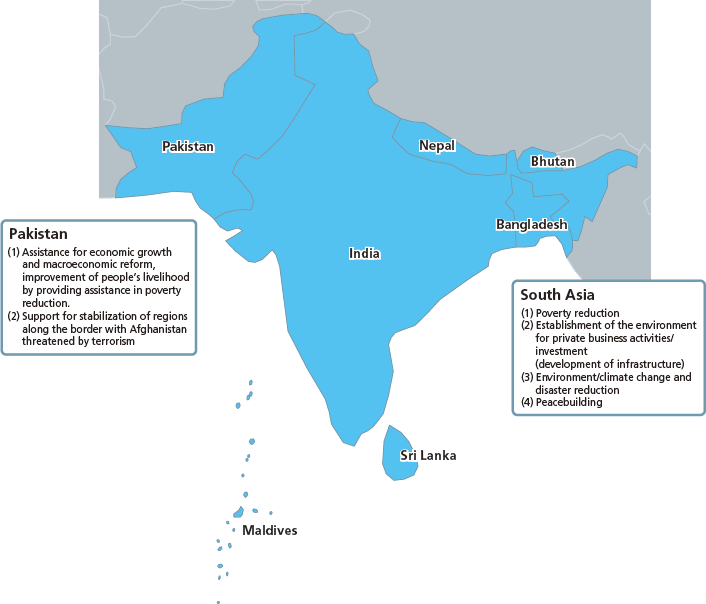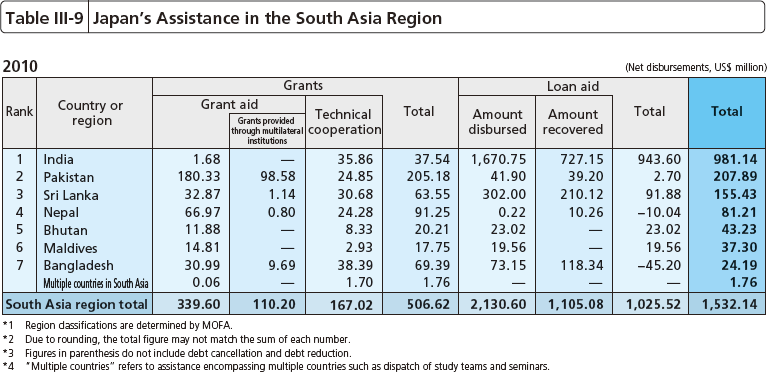Japan's Official Development Assistance White Paper 2011
2. South Asia
The South Asian region that has a high rate of economic growth and enormous economic potential, particularly India, the world's largest democracy, strengthens its presence in the international community. Geographically, South Asia is strategically important to Japan because of its location on a sea lane that connects East Asia with the Middle East, and the global environmental issues as well. In addition, the region is of great concern to Japan and the rest of the international community due to the role the region plays in international efforts against terrorism and extremism.
At the same time, the South Asian region still faces a large number of issues that must be addressed, including a severe lack of basic infrastructure like roads, railroads, and ports, growing populations, low school enrollment ratios in primary education, undeveloped water, sanitation, healthcare and medical facilities, insufficient maternal and child healthcare, a lack of countermeasures against infectious diseases, and the absence of the rule of law. The poverty reduction is a particularly significant problem. Approximately 500 million people of 1.5 billion of the region's population are said to be living in poverty, making it one of the world's poorest regions. South Asia is the second most important region behind Africa in aiming to achieve the Millennium Development Goals (MDGs).(Note 24) Japan provides assistance focused on improving the socio-economic infrastructure in order to harness the economic potential of South Asia as well as to alleviate the growing gap between the rich and the poor.
<Japan's Efforts>
In its relationship with India, a central presence in South Asia, Japan promotes cooperation in a wide range of fields in accordance with the "Strategic and Global Partnership." These include politics and security, economy, economic cooperation on projects such as the Dedicated Freight Corridor (DFC) which runs through the Delhi Mumbai Industrial Corridor (DMIC), and scholarly exchange. India is the largest recipient of Japan's ODA loans, and Japan focuses on the assistances of development of economic infrastructure, mainly in the area of power and transportation and social sector development and poverty reduction through improving the environment of rural area.
In May 2009, the military conflict between government troops and the Liberation Tiger of Tamil Eelam (LTTE) that had lasted almost 26 years in Sri Lanka came to an end. Japan provides aid to promote peacebuilding and socio-economic development in Sri Lanka, while giving consideration to regional and ethnic balance.
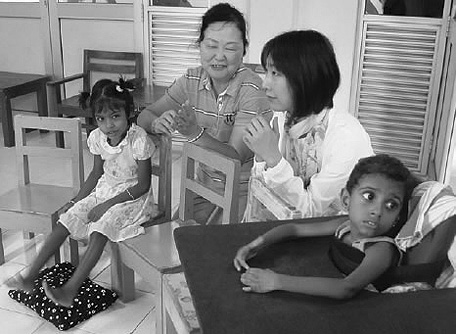
Parliamentary Vice-Minister for Foreign Affairs Makiko Kikuta observes a children's support center in Sri Lanka, where a Japan Overseas Cooperation Volunteer serves
Pakistan plays an important role as a front-line state in "fight against terrorism." At the Pakistan Donors Conference held in Tokyo in April 2009, Japan pledged up to $1 billion in aid for Pakistan over the next two years. Japan has been steadily providing aid in accordance with the New Strategy to Counter the Threat of Terrorism that was announced in November 2009. Japan provided support to Pakistan in response to the disastrous flood occurred in late July 2010. Japan's emergency assistance to the flood disaster is emergency grant aid, as well as the contribution of personnel through dispatch of six helicopters of Self-Defense Forces and medical teams of the Japan Disaster Relief. At the Pakistan Development Forum in November 2010, Japan announced $500 million in aid and other assistance(Note 25) for Pakistan's recovery from the flood disaster. In addition, when President Asif Ali Zardari visited Japan in February 2011, the Joint Statement on Japan-Pakistan Comprehensive Partnership was signed, and Japan agreed to continue providing support to enhance mutually beneficial economic and trade interaction, to assist Pakistan in efforts to develop the power sector, water resources, and infrastructure, and to ensure human security.
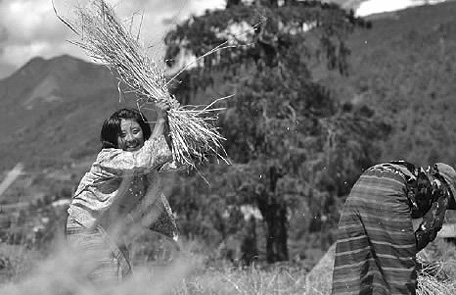
Women threshing rice on a rock in Bhutan (Photo: Kensaku Seki/JICA)
In addition, efforts toward aid coordination (see "Terminology" on page 138) are proceeding in other countries of South Asia as well. In Bangladesh, for example, the Joint Cooperation Strategy (JCS) was formulated in June 2010 with the participation of 18 countries and organizations, including Japan, the World Bank, the Asian Development Bank (ADB), and the UK's Department for International Development (DFID), for the purpose of supporting implementation of the revised Second National Strategy for Accelerated Poverty Reduction (NSAPR-II).* Japan is working proactively to coordinate aid in order to provide effective and efficient assistance in Bangladesh.
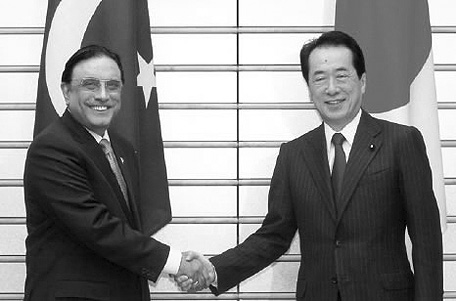
Prime Minister Naoto Kan meets with the Islamic Republic of Pakistan's President Asif Ali Zardari on his visit to Japan (Photo: Cabinet Public Relations Office)
Terminology
*Poverty Reduction Strategy Paper (PRSP)
A document introduced in 1999 by the World Bank's International Monetary Fund (IMF) as a condition for heavily indebted poor countries (poor countries that have an enormous amount of debt) to receive debt relief. It is an action plan for socio-economic development with goals set every three years in the areas of education, healthcare, food security, and other areas, to provide payments of funds not repaid due to debt relief, for measures to reduce poverty. The Paper was created incorporating the views of representatives from aid-giving countries, NGOs, research institutes, and the private sector, under the ownership (independent efforts) of the governments of developing countries.)
Notes:
(24) According to the 2010 MDGs Report, the percentage of people living on approximately one dollar per day was 39% (as of 2005), a figure only exceeded by Sub-Saharan Africa.
(25) The total amount of aid for flood damage pledged by Japan was $568 million.
[India]
"Delhi Mass Rapid Transit System Construction Plan Phase 2"
ODA Loan (January 2006 - December 2010)
In Delhi, India's capital, a dramatic increase in population and a rise in popularity of personal vehicles have created acute problems of chronic traffic jams and air pollution. Japan provides ODA loans (Phase 1: ¥162.7 billion; Phase 2: ¥211.9 billion) for the construction of underground and elevated railway systems in Delhi, thereby contributing significantly to the improvement of urban environment. At the phase 1, the primary objective was alleviating traffic congestion in commercial and government districts in central Delhi, and phase 2 is aimed to establish radiating lines from the city center to outer Delhi, and further improvement of transport access to the city of Delhi from the major economic regions. The total length is approximately 190 km, with two million passengers travelling along the line per day, a foothold as transportation for the citizens.
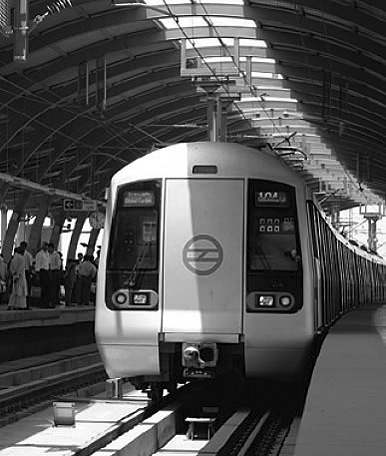
A station on the Delhi Metro subway line (Photo: JICA)
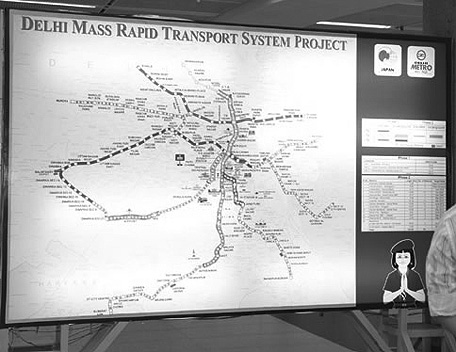
A route map in the station building (Photo: Shinichi Kuno/JICA)
Japan’s international cooperation policy in the South Asia Region
